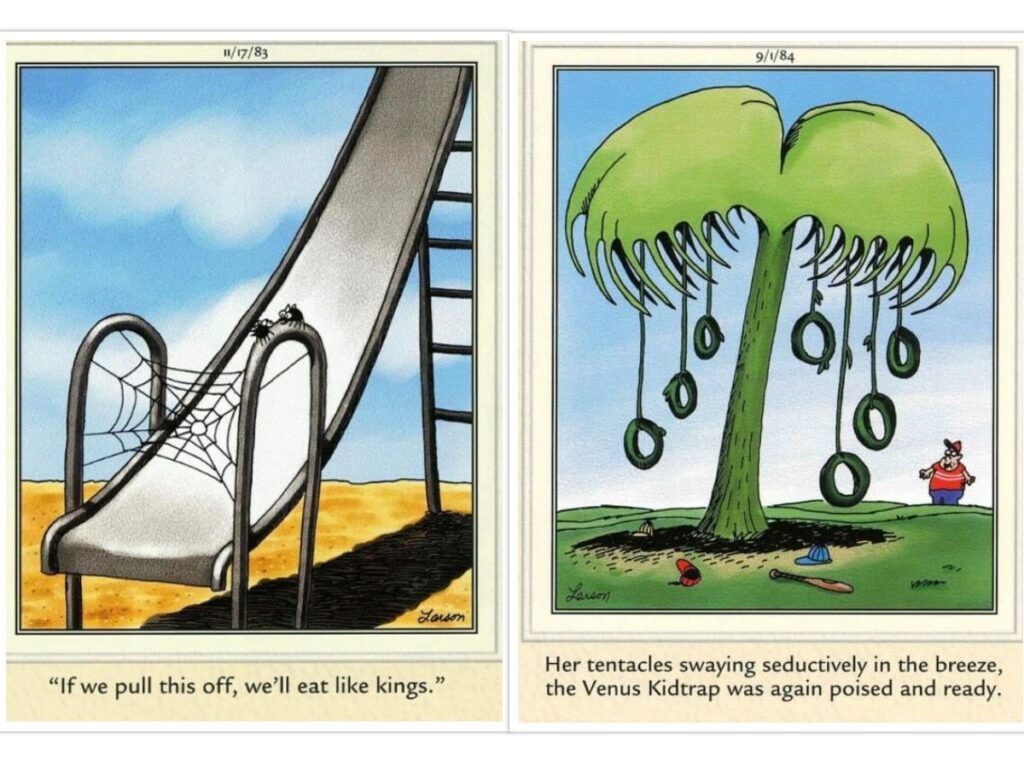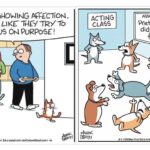Discovering Laughter with “The Far Side” Comic Strips
A World of Whimsical Wit
“The Far Side” is a name that conjures up images of cows walking upright, scientists with wild hair, and kids who bring hilarious surprises home. This single-panel comic strip, created by Gary Larson, became a staple of newspaper funny pages and a cultural phenomenon. Known for its offbeat humor and clever twists, “The Far Side” takes readers to a place where the absurd becomes the everyday. The strip’s unique brand of humor has been making people laugh since its debut in 1980, and it remains a beloved piece of comic artistry.
The Essence of “The Far Side” Humor
What sets “The Far Side” apart in the world of comic strips is its ability to find humor in the most unexpected places. Larson’s imagination stretches from the prehistoric times of dinosaurs to the quirky corners of suburban life. Each comic strip serves as a snapshot of a world turned sideways, where animals often reflect human traits and science experiments go amusingly awry. Larson’s work is a testament to the power of humor to create a shared moment of joy, eliciting a laugh with a simple image and a witty caption.
The Far Side’s Impact on Pop Culture
Since its inception, “The Far Side” has had a substantial impact on pop culture. The strip’s signature style is instantly recognizable, and its phrases and scenarios have seeped into everyday language. Larson’s ability to poke fun at the natural world, human behavior, and everything in between resonates with a universal audience. It’s this universal appeal that has allowed “The Far Side” to maintain its status as one of the most popular and enduring comic strips in history.
Laughter as a Universal Language
“The Far Side” proves that laughter is a universal language. Whether it’s a scientist making a humorous mistake or a dog plotting the day’s shenanigans, Larson captures a humor that transcends age and culture. The strip encourages readers to laugh at the complexities and absurdities of life, providing a daily dose of levity in a world that often takes itself too seriously. This universal appeal has enabled “The Far Side” to endure, even years after the last strip was published.
The Legacy of “The Far Side”
Though Gary Larson has retired from daily cartooning, “The Far Side” continues to be discovered by new fans and treasured by those who have followed it for years. The complete body of “The Far Side” work remains in print, available for anyone in need of a laugh. Its legacy is that of a comic strip that redefined the genre, using single-panel illustrations to reveal the hilarity hidden in the corners of our minds. “The Far Side” stands as a pinnacle of humor, proving that a comic strip can do more than just make us laugh—it can make us view the world in a whole new, delightfully skewed way.
Credit: The Far Side
1
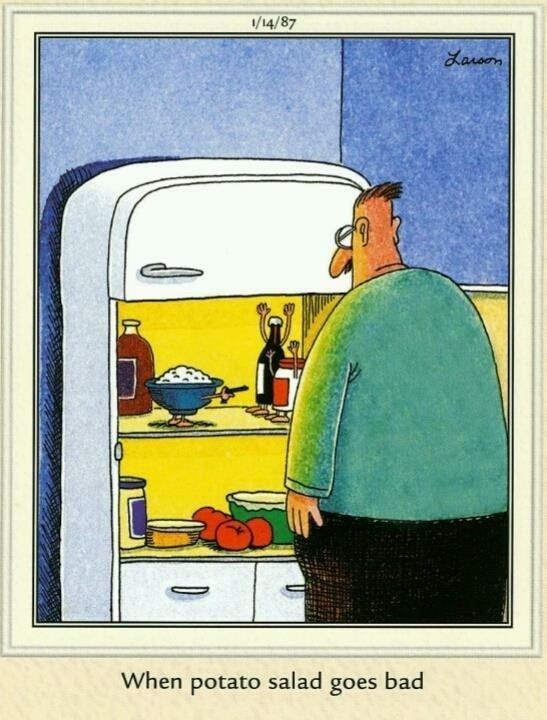
This image is a humorous comic from “The Far Side” by Gary Larson. It shows a man standing in front of an open refrigerator looking at a bowl of potato salad that has come to life. The potato salad has grown a face and limbs, and it’s standing on the shelf holding a small gun. It appears to be causing trouble inside the fridge, which plays on the phrase “when potato salad goes bad,” using a pun to suggest the food has spoiled and become dangerous. The date on the comic is January 14, 1987. The humor comes from the literal interpretation of a common expression about food spoiling.
2
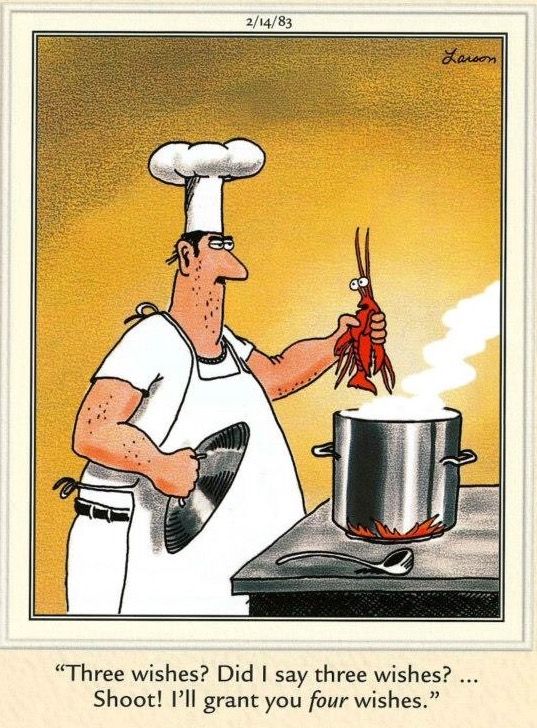
This is another comic from “The Far Side” series by Gary Larson. The image shows a chef in a kitchen holding a lobster over a pot of boiling water. The chef looks surprised because the lobster seems to be talking to him. The caption of the comic says, “Three wishes? Did I say three wishes? … Shoot! I’ll grant you four wishes.” The joke is that the lobster is trying to bargain for its life by offering the chef more wishes, like a genie would, in order to avoid being cooked. The date on the comic is February 14, 1983. The humor lies in the absurdity of the situation and the play on the common fairy tale theme of granting wishes.
3
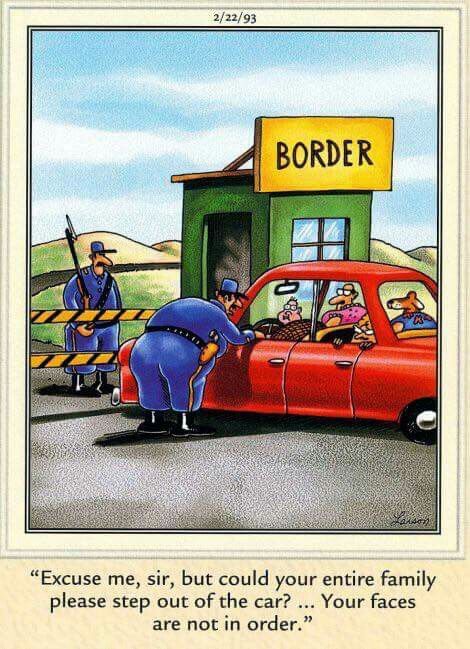
This image is a comic strip from “The Far Side” by Gary Larson. It depicts a comical situation at a border crossing. A border security officer is talking to a family in a car, asking them to step out because “Your faces are not in order.” The humor here is that instead of the passports or paperwork being out of order, it is literally the family’s faces that are jumbled up and in the wrong order on their heads. The date on the comic is February 22, 1993. The scene is humorous because it’s absurd and plays on the expectations of a border control checkpoint.
4
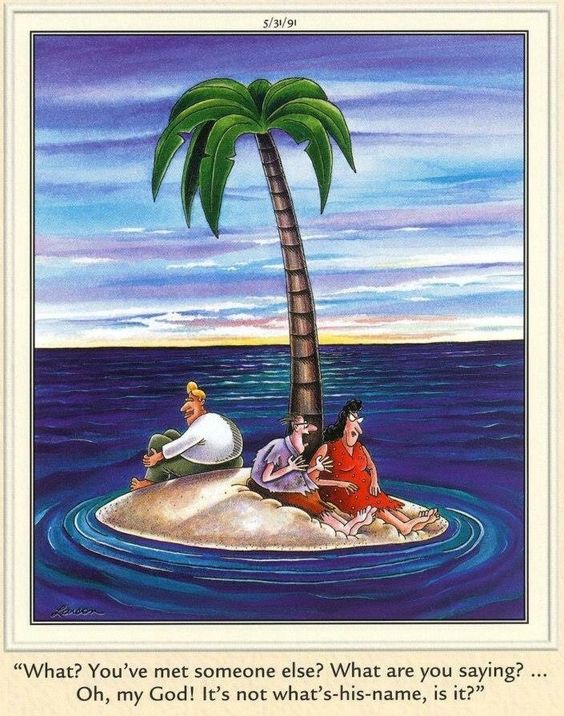
The image is a comic from “The Far Side” by Gary Larson, dated May 31, 1991. It features three people stranded on a tiny desert island with just one palm tree. Two of them appear to be arguing. The woman seems upset, saying, “What? You’ve met someone else? What are you saying… Oh, my God! It’s not what’s-his-name, is it?” The joke is that they are in such a small and isolated place that the idea of meeting someone new is absurd. The humor arises from the contrast between the desperate situation of being stranded and the mundane, almost soap opera-like concern about romantic troubles.
5
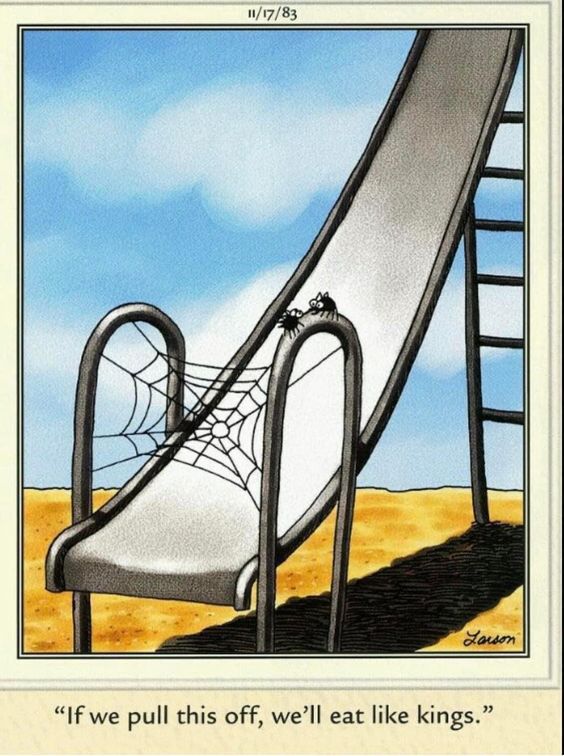
The image is a comic from “The Far Side” by Gary Larson, dated November 17, 1983. It shows a slide in a playground with a large spider web spun across the bottom where children would normally land. There are two spiders on the web, and one seems to be speaking to the other, saying, “If we pull this off, we’ll eat like kings.” The humor comes from the spiders planning to catch something big with their web placed at the bottom of the slide, like a trap, and their anticipation of a large feast as a result. It’s a play on the idea of setting up a perfect trap in an unexpected place. The joke is that the spiders are thinking ambitiously, as the web is disproportionately large for typical prey, hinting at catching something or someone much larger, like children using the slide..
6
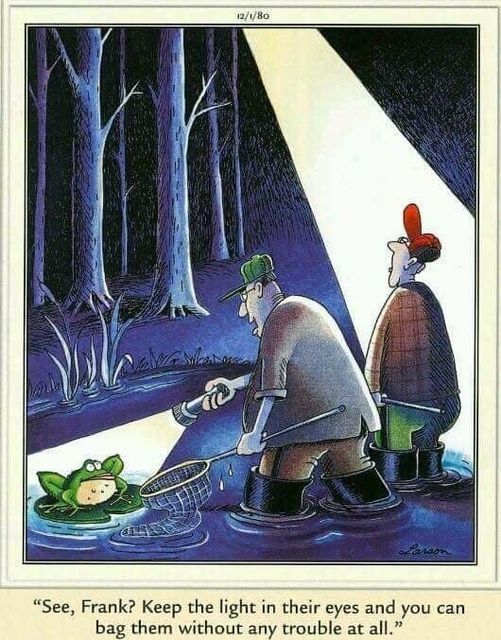
The image is a comic from “The Far Side” by Gary Larson, dated December 1, 1980. It illustrates two hunters at night in the woods, standing in a swampy area. One hunter is shining a flashlight on a frog that is sitting calmly with a shopping bag, while the other hunter is about to catch the frog with a net. The hunter with the flashlight says, “See, Frank? Keep the light in their eyes and you can bag them without any trouble at all.”
The humor here is multi-layered. It’s a twist on the idea that animals like deer or rabbits get frozen in place by bright lights at night, making them easy to catch. But in this comic, it’s a frog who is not only unafraid but seemingly ready to be caught, with its own shopping bag, suggesting it’s going to the store or expecting to be collected like groceries. It’s funny because it’s such an absurd and human-like situation for a frog.
7
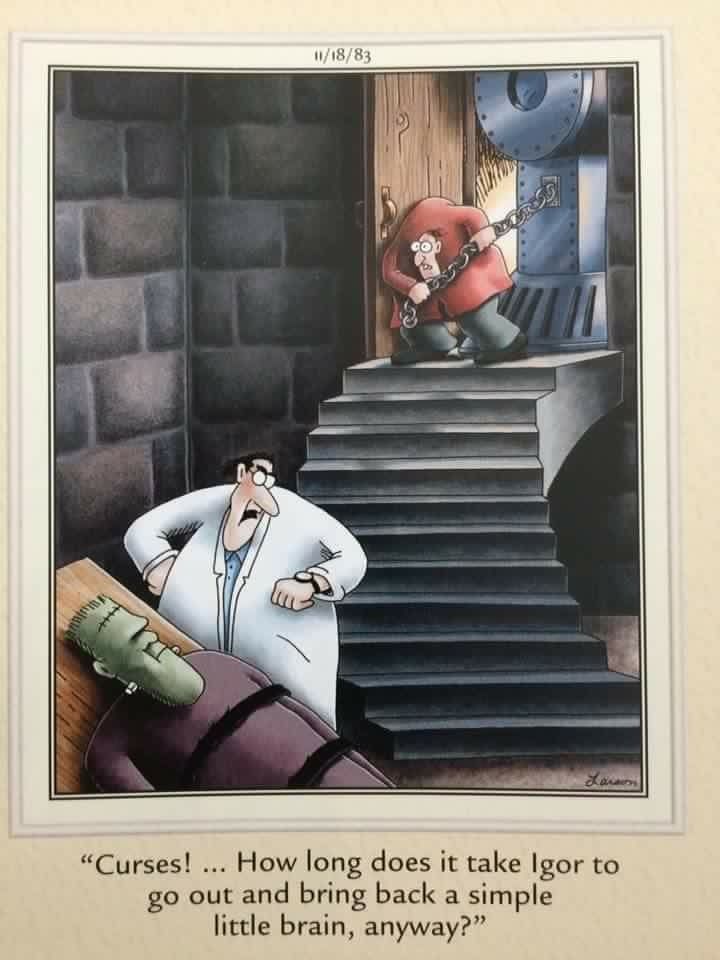
This image is a cartoon from “The Far Side” comics. In the picture, there are three characters in what looks like a dark, stone castle. One character is a large green monster lying on a table; this is a humorous take on Frankenstein’s monster. The second character is a scientist wearing glasses and a white lab coat, standing with an annoyed expression. The third is a hunchbacked assistant wearing a red shirt and green pants, carrying a heavy chain, who looks tired and is walking down the stairs. The text below the image, which is meant to be funny, reads: “Curses! … How long does it take Igor to go out and bring back a simple little brain, anyway?” This suggests that the assistant, presumably named Igor, has been sent to find a brain for the monster on the table, but is taking a long time to do so, causing the scientist to become impatient. The humor comes from the play on the classic horror story of Frankenstein, where a scientist creates a monster and needs a brain to bring it to life.
8
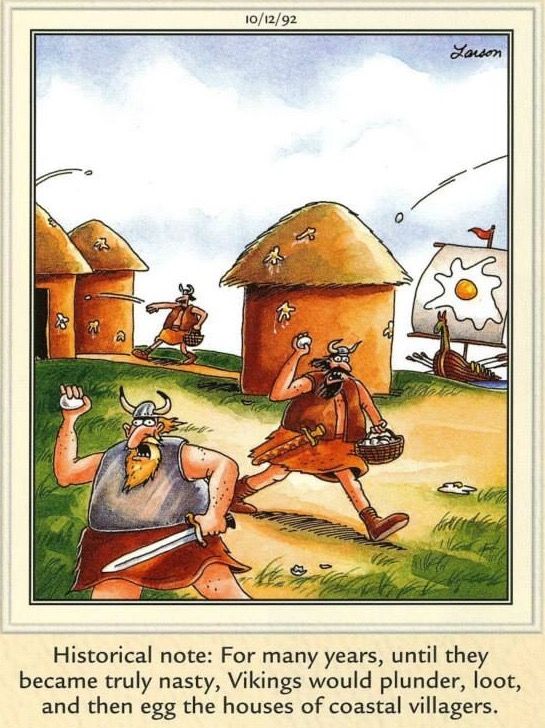
This is another cartoon from “The Far Side” comics. The scene shows two Vikings: one with a horned helmet is shouting and shaking his fist, and the other is running with a basket of eggs, throwing them at the houses of a village. The houses look simple and round with thatched roofs, and you can see eggs splattered on them. There’s also a Viking ship in the background. At the bottom, there’s a caption that reads, “Historical note: For many years, until they became truly nasty, Vikings would plunder, loot, and then egg the houses of coastal villagers.” This is a joke that plays on the real historical behavior of Vikings, who are known for raiding and plundering, but in this humorous take, they are just throwing eggs at houses, which is a relatively harmless prank compared to their actual violent activities. The humor is in the absurdity of fierce Vikings engaging in such a childish act.
9
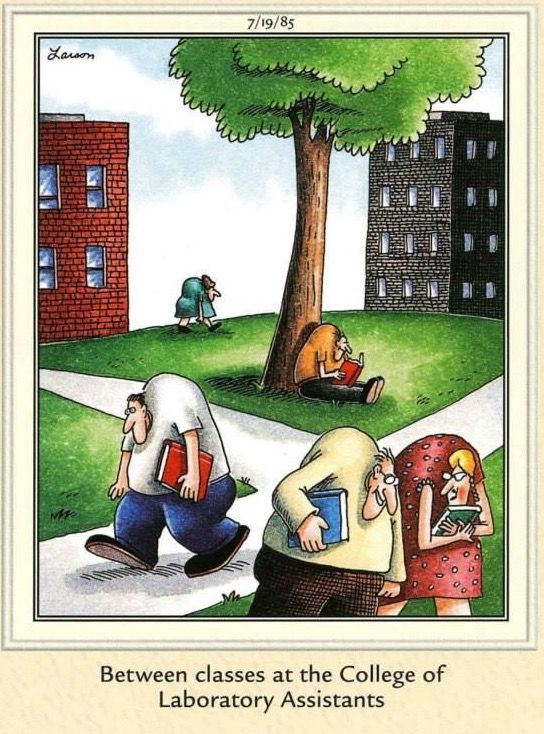
This cartoon is from “The Far Side” comics. It shows a humorous scene labeled “Between classes at the College of Laboratory Assistants.” In the image, there are four people walking hunched over like primates, which is a funny reference to the early stages of human evolution. They are on a college campus, with a brick building on one side, a tree, and a modern building on the other. Each person is carrying books, suggesting they are students or assistants going between classes, but the way they walk and their posture are more like that of early humans or apes, not modern humans. This is a play on the idea that laboratory assistants are often seen as doing the basic groundwork in science, much like early humans did in the evolutionary process. The cartoonist is using this image to make a joke about the evolution of knowledge and the role of assistants in the scientific community.
10
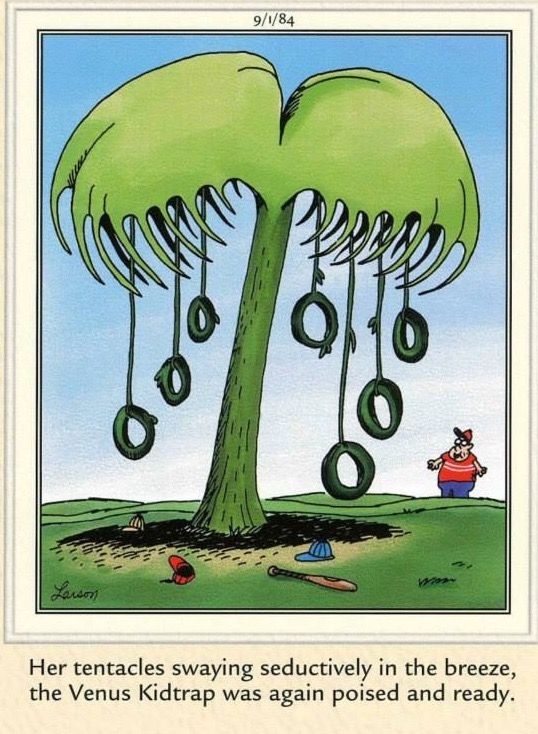
This image is a cartoon from “The Far Side” comics. It shows a large, imaginary plant with a shape similar to a Venus flytrap, except it has swing seats hanging from its “tentacles” instead of traps. The swings look like the ones children use at a playground. Below the plant, there is a small child, dressed in a striped shirt and pants, looking up at the swings. The caption reads, “Her tentacles swaying seductively in the breeze, the Venus Kidtrap was again poised and ready.” This is a humorous twist on the Venus flytrap, a real plant that catches insects, but in the cartoon, the plant is called a “Venus Kidtrap” and appears to be waiting to catch children with its enticing swing seats. The humor comes from the idea of a plant “hunting” in a way similar to how a Venus flytrap does, but for children who might be attracted to the swings.
Conclusion: The Enduring Charm of “The Far Side”
In the world of comic strips, “The Far Side” has secured its place as an indelible source of humor and a beacon of creativity. Gary Larson’s ability to marry the mundane with the bizarre has not only brought about laughter but has sparked imaginations across the globe. The comic’s legacy is not solely in the chuckles it induces but in its commentary on life’s ironic twists and the shared experiences that unite us. “The Far Side” remains a testament to the enduring power of a well-crafted comic strip to spread joy, provoke thought, and, most importantly, remind us of the value of a good laugh. Even as the panels have ceased, the laughter continues, echoing the timeless appeal of Larson’s work and the universality of humor found in the far-reaching corners of “The Far Side.”
You Can Also Read More Comics on our website Just click the given Link below

